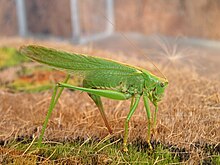Eastern hay horse
| Eastern hay horse | ||||||||||||
|---|---|---|---|---|---|---|---|---|---|---|---|---|

Eastern hayhorse ( Tettigonia caudata ) |
||||||||||||
| Systematics | ||||||||||||
|
||||||||||||
| Scientific name | ||||||||||||
| Tettigonia caudata | ||||||||||||
| ( Charpentier , 1842) |
The eastern hayhorse ( Tettigonia caudata ) is a long-nosed insect from the family of the whooper terrors within the superfamily of the leaf locust . It is very similar to both the twittering insect and the green hay horse. So far, two subspecies have been distinguished.
features
The eastern hayhorse looks very similar to the two other Tettigonia species that occur in Central Europe , the chirping insect and the green hayhorse . In terms of wing length and body length, however, it stands between these two types. It also has small black thorns on the thighs of the last pair of legs. The abdomen is short and thin, the pronotum is small and slightly elongated towards the back. The legs are long and strong. The species has remarkably long antennae, these reach back over the wing tips. Their basic color is light green. Often their wings and the upper side of their thorax are brown in color. The compound eyes are gray with a blurred dark point in the middle. In the female, the gray-green ovipositor protrudes over the wings by about 10 millimeters. In contrast to the green hay horse, the male's cerci and styli are of the same length.
Way of life
Like the green hay horse, the eastern hayhorse feeds on insects and their larvae as well as plants. His singing consists of short, swelling whirring verses. It is quieter and more subdued than the twittering insect and can only be heard about 10 to 20 meters away. The animal can be found on the ground or on low herbaceous plants or shrubs.
distribution
The eastern hay horse inhabits open and bushy grasslands up to steppe-like areas. In the vicinity of humans, it also lives in grain fields and on roadsides and roadsides. It occurs in Germany in Berlin , Brandenburg and sporadically in the rest of eastern Germany and is quite rare. In the Red List of Threatened Species it is listed as a species with geographical restrictions.
Outside Germany, the distribution area extends from Belgium , Austria and Switzerland via Italy with some coastal islands in the northern Tyrrhenian Sea , the Czech Republic and Slovakia to Hungary . A demarcated occurrence of the species can be found in Turkey , Azerbaijan , Armenia and Georgia , and another in Kyrgyzstan .
Systematics
So far, two subspecies are known:
- T. c. caudata (Charpentier, 1842) - the nominate form - occurs in Europe
- T. c. mistshenkoi Ozerskij, 1989 - occurs in Kyrgyzstan
Synonyms of the subspecies caudata are T. armeniaca , T. kolenatii , T. longicauda and T. prasina .
swell
literature
- Heiko Bellmann : The Cosmos Locust Leader. Determine the species of Central Europe with certainty. Franckh-Kosmos Verlags GmbH & Co. KG, Stuttgart 2006, ISBN 3440104478
Web links
- Tettigonia caudata at Fauna Europaea. Retrieved August 26, 2011
- Orthoptera Species File
- Tettigonia caudata at Orthoptera.ch
- photos
